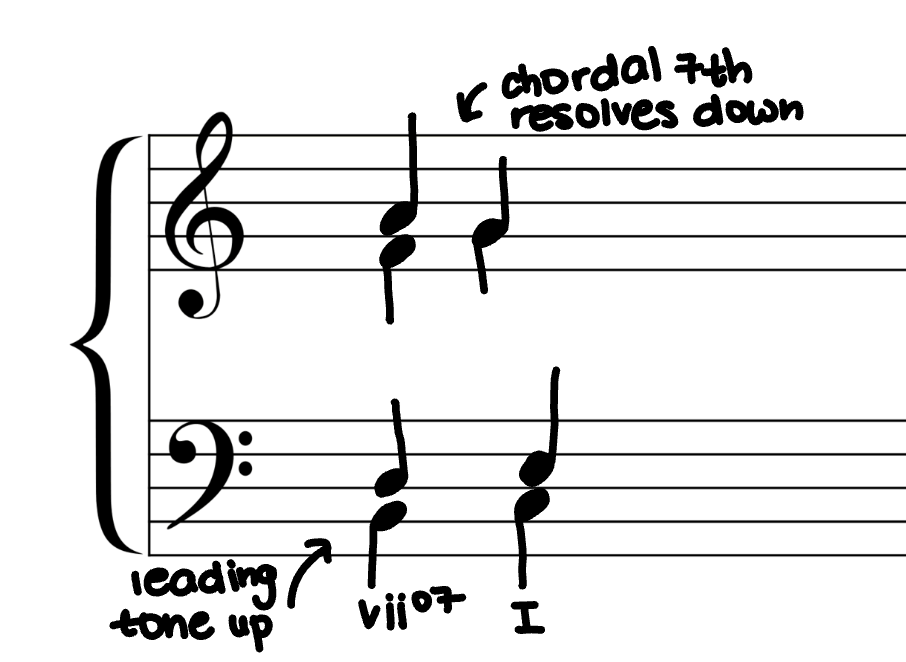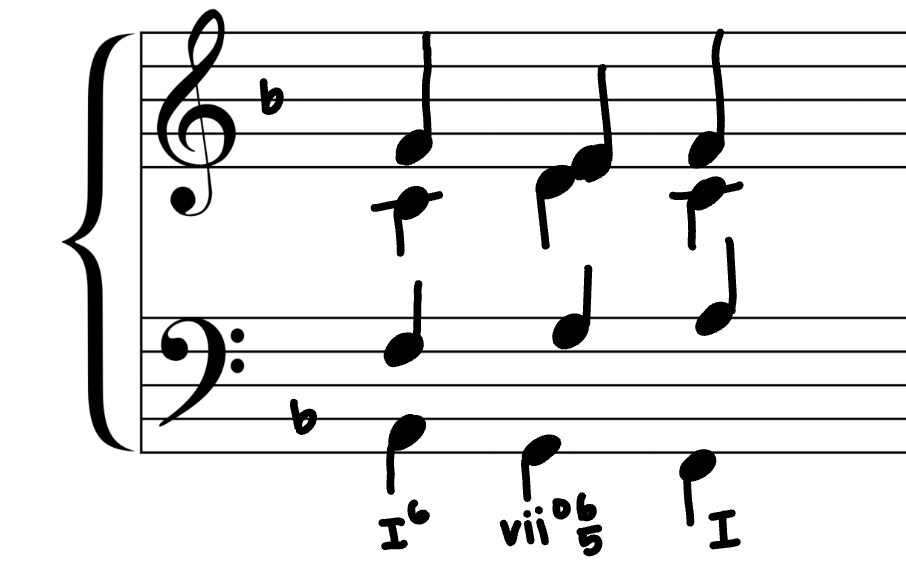4.5 Voice Leading with Seventh Chords in Inversions
7 min read•june 18, 2024
Mickey Hansen
AP Music Theory 🎶
72 resourcesSee Units
Voice Leading with Seventh Chords
As a general rule, when we write inversions of sevenths chords in a harmonic progression, it is important to keep entry and exit of the chord through a stepwise motion. Minimal or no leaps in or out of a seventh chord is essential. Seventh chords in inversions often allow the bass to have a melodic stepwise quality. Just like those walking bass players in jazz!
Leading Tone Seventh Chords
Leading-tone seventh chords, the ⅶo7 diminished and ⅶø7, have two possible functions:
- To substitute for the Ⅴ or Ⅴ7 chord as part of the dominant, or
- Placed between tonic chords, to prolong the tonic in a stepwise voice leading
Let’s see an example of both. First, consider a vii7-I cadence. Remember that the vii7 has a dominant function because the leading tone resolves well to the tonic. Usually, we use this chord in root position, which gives a stronger leading tone-tonic resolution. We can also use it in some other inversion where the leading tone is in the top voice. This will also give this progression a strong resolution.

Using inversions is more useful in the second case, where we place the vii chord between two tonic chords. While we can use this in root position, perhaps with a I-vii6/5-I progression, we can also use it in first inversion to create a voice exchange. Here is an example:

Inversions of the ii7 chord are also used quite a bit in music. We will cover this in later units!
Omitting Voices
Remember that inverted chords should contain all the tones of the chord. While it is okay to omit chord tones in a seventh chord in root position, any inversion chords cannot do so. Keep them all!

🦜 Polly wants a progress tracker: If you have a V7 chord in the key of A Major, what is the 7th chord tone and to what note will it resolve?
Unit 4 Voice Leading Rules Summary
We’ve covered a TON of voice leading rules thus far. Let’s take a step back and summarize all of them, starting with Unit 4.1.
General Voice Leading Rules and Considerations:
- Voice leading should proceed mostly by step without excessive leaps.
- When possible, pitches common to adjacent chords, or common tones, should be retained in the same voice part(s).
- For clarity of voice leading, any chord should maintain soprano-alto-tenor-bass (SATB) order from high to low to avoid voice crossing.
- If a perfect fifth between two voices is not immediately repeated, it should proceed to an interval other than another perfect fifth between the same voices. This applies to parallel motion (i.e., parallel fifths) as well as contrary motion; it also applies to nonadjacent chords on successive beats.
- If a perfect octave or unison between two voices is not immediately repeated, it should proceed to an interval other than another perfect octave or perfect unison between the same voices. This applies to parallel motion (i.e., parallel octaves) as well as contrary motion; it also applies to nonadjacent chords on successive beats.
- All voices should proceed melodically with the following intervals—major and minor second, major and minor third, perfect fourth, and perfect fifth. All melodic augmented and diminished intervals should be excluded, as they produce uncharacteristic dissonances. All melodic intervals larger than a perfect fifth should also be excluded, as they create uncharacteristic disjunct motion.
- The leading tone in an outer voice (i.e., soprano or bass) should always resolve up by step to avoid an unresolved leading tone
- Outer voices may include leading tones as long as those leading tones are not doubled in another voice and resolve to the tonic by ascending in stepwise motion, to avoid an unresolved leading tone.
- All implied chords must allow the corresponding soprano notes to make harmonic sense.
- An acceptable harmonic progression can be made using tonic, supertonic, subdominant, and dominant triads exclusively, as long as the normative procedures of harmonic progression are followed.
- Repeated instances of a specific harmony— that is, repeating a particular chord in a particular position (root position or inversion)— are acceptable only if the repeated harmonies start on a strong beat. However, at the beginning of a phrase, the repeated harmonies may start on a weak beat.
- Melodic interest in a bass line may be created by balancing upward and downward motion and by balancing melodic steps and leaps.
- A bass line uses melodic leaps with greater frequency than upper voices or parts, which tend toward more stepwise motion.
- Allowable leaps include thirds, perfect fourths and fifths, sixths, and octaves, and, if resolved properly, descending diminished fifths.
- Octave leaps should be followed by changes in direction.
- The bass line may include successive leaps in the same direction as long as the pitches outline a triad.
- Repeated bass notes are acceptable only if they start on a strong beat. However, the repeated notes may start on a weak beat if it is the beginning of a phrase or if the second note is a suspension.
- Although bass lines may feature note values ranging from half notes to eighth notes, the quarter note is the most frequent rhythmic value
Parallel Voices
- Avoid parallel fifths and parallel octaves. Parallel fifths and octaves occur when two outer voices move in similar motion and they maintain the same perfect fifth or octave interval between the voices
- Also avoid direct fifths and direct octaves, which occurs when you retain the same perfect interval between two inner voices, or between one outer voice and one inner voice
- Additionally, avoid three consecutive thirds and three consecutive sixths between voices
- Avoid rising unequal fifths, where an interval of a diminished fifth between two voices resolves to a perfect fifth
Doubling and Spacing Rules
- Double the root of a triad whenever voice leading allows.
- Thirds and fifths may also be doubled in triads when they result in good voice leading.
- In all situations, always double non-tendency tones (i.e., tones other than the leading-tone and chordal seventh).
- If the fifth is omitted in a root-position seventh chord, double the root.
- Following a complete root position V7, the tonic triad may have three roots and a third (no fifth).
- In 6/4 chords, always double the bass
- In general, upper voices should be less than an octave apart
Seventh Chords
- Chordal sevenths should be approached by common tone or by step. When the voice-leading context precludes these options, chordal sevenths may also be approached by ascending leap or (rarely) by a descending leap of a third.
- All chordal sevenths should resolve by a descending step, to avoid an unresolved seventh. However, the chordal seventh in a V4/3 chord may move up by a step when appearing in a I-V4/3-I6 progression. In some cases, the chordal seventh may be retained in the same voice before resolving down by a step.
- The fifth of a root-position dominant seventh chord may be omitted if it helps the voice leading. When the fifth is omitted in a root position seventh chord, the root should be doubled.
- All inverted seventh chords must be spelled completely in writing the chord.
Cadences
- Harmonic progressions and phrases should end with a cadence
- Authentic cadences are used to create a sense of resolution and finality for phrases. They have a V-I or V-i chord progression. Sometimes, there will be a vii chord between the dominant and the tonic to prolong the dominant area. You can have perfect authentic cadences or imperfect authentic cadences. In perfect authentic cadences, both the dominant and the tonic chords are in root position, so there is a stronger sense of resolution. In imperfect authentic cadences, either one or both of the chords may be inverted. Imperfect authentic cadences provide a weaker sense of resolution.
- Half cadences end on a dominant chord. Usually, half cadences will be a vi-V or VI-V progression, but that is not always the case. By ending on a dominant chord, half cadences give some sense of resolution without fully finishing the phrase. They are best used in the middle of a piece, when transitioning from one phrase to another.
- Deceptive cadences try to trick listeners into thinking that there will be resolution, but they don’t provide a resolution. Deceptive cadences go from a dominant chord to some other chord. Usually, the vi chord follows the dominant chord in deceptive cadences. They are often used to prolong phrases and create tension
- Finally, plagal cadences are a IV-I or iv-i progression. They give a weaker sense of resolution than authentic cadences, but the phrase will still sound resolved. Plagal cadences were used a lot in church music (hence the name) and they are used in several modern pop songs as well.
Make sure to remember these voice leading rules for the AP Music Theory exam! While it is true that some of the rules are more important than others, you should at least be aware of all the voice leading rules – sometimes, even if a voice leading rule is not on the rubric of a free response question, the multiple choice section may ask about it.
Browse Study Guides By Unit
🎵Unit 1 – Music Fundamentals I (Pitch, Major Scales and Key Signatures, Rhythm, Meter, and Expressive Elements)
🎶Unit 2 – Music Fundamentals II (Minor Scales and Key Signatures, Melody, Timbre, and Texture)
🎻Unit 3 – Music Fundamentals III (Triads and Seventh Chords)
🎹Unit 4 – Harmony and Voice Leading I (Chord Function, Cadence, and Phrase)
🎸Unit 5: Harmony and Voice Leading II: Chord Progressions and Predominant Function
🎺Unit 6 – Harmony and Voice Leading III (Embellishments, Motives, and Melodic Devices)
🎤Unit 7 – Harmony and Voice Leading IV (Secondary Function)
🎷Unit 8 – Modes & Form
🧐Exam Skills
📚Study Tools

Fiveable
Resources
© 2025 Fiveable Inc. All rights reserved.